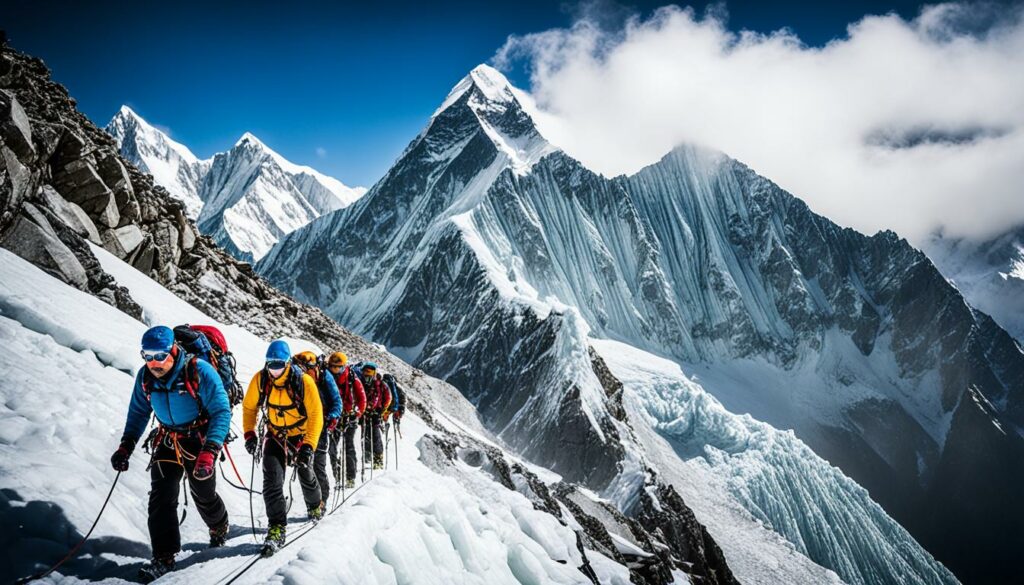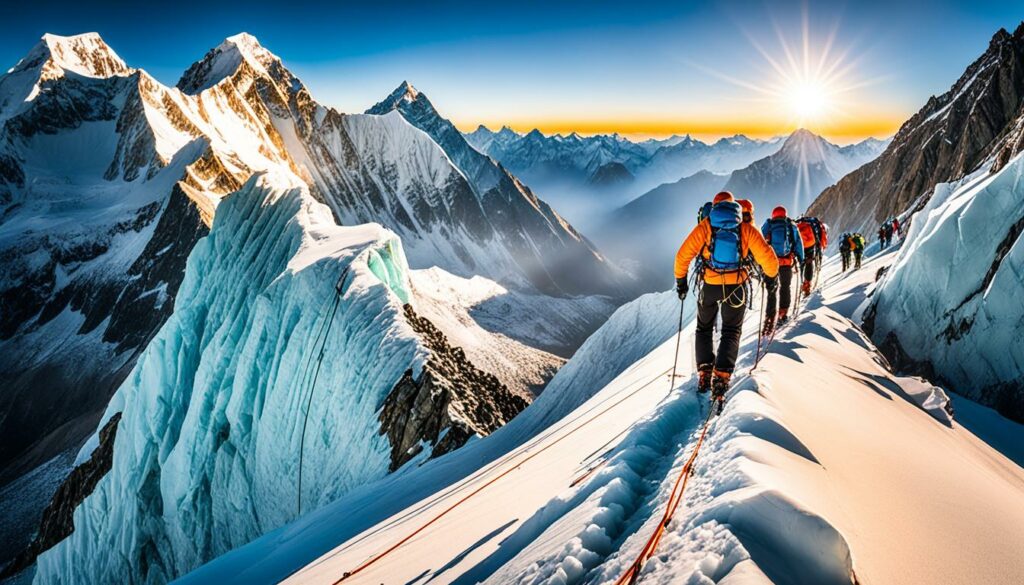“The mountains are calling and I must go.” – John Muir
Welcome to the majestic world of climbing Lhotse, the fourth highest peak in the world. Located in west-central Nepal, Lhotse offers a thrilling and challenging expedition for avid mountaineers. Known for sharing the same route as Mount Everest but at a lower cost, climbing Lhotse presents a unique opportunity to experience the Himalayas in all their breathtaking glory.
Navigating the Lhotse climbing route requires more than just physical strength; it demands the right skills, experience, and logistical expertise. As you embark on this extraordinary journey, join us in exploring the preferred climbing routes, expedition logistics, required gear and equipment, health and fitness preparation, and much more. Get ready to unlock the secrets of Lhotse and discover what it takes to conquer this formidable peak.
Key Takeaways:
- Choose the right climbing route, such as the West Face Couloir or Southeast Ridge, to summit Lhotse.
- Ensure proper expedition logistics, including climbing permits, base camp setup, and Sherpa support.
- Equip yourself with the necessary climbing gear and equipment for safety and success.
- Prioritize health and fitness preparation, including altitude acclimatization and physical training.
- Understand the challenges, risks, and statistics associated with climbing Lhotse to make informed decisions.
Preferred Climbing Routes
When it comes to climbing Lhotse, one of the world’s highest peaks, choosing the right route can make all the difference. Among the various options available, the most popular climbing route for Lhotse is the West Face Couloir. This route follows the same path used to summit Mount Everest’s Southeast Ridge and offers an exciting and challenging adventure for climbers.
Embarking on the West Face Couloir route means traversing through the renowned Khumbu Icefall, a treacherous section that demands utmost caution. This icy labyrinth presents its own share of challenges, with its constantly shifting ice formations and crevasses.
The final stretch of the climb entails navigating a steep and rock-filled gully in the last 300 meters. This section is particularly hazardous due to the increased risk of rockfall. Climbers must exercise vigilance and take necessary precautions to ensure their safety.
“The West Face Couloir route is an exhilarating endeavor that combines the thrill of ascending Lhotse with the renowned leg of the Mount Everest route. It offers a unique and unforgettable experience for climbers seeking a challenging high-altitude adventure.” – Experienced climber
Comparison of Lhotse and Mount Everest Routes:
| Lhotse (West Face Couloir) | Mount Everest (Southeast Ridge) |
|---|---|
| Takes the same path as Mount Everest beyond a certain point | Main route and standard path to Mount Everest summit |
| Offers a more affordable alternative to Mount Everest climb | Considered the pinnacle of mountaineering achievements |
| Presents unique challenges and dangers specific to Lhotse | Famous for its massive crowds during peak climbing seasons |
The West Face Couloir route provides climbers with a captivating and rewarding journey, combining the allure of Lhotse with a section of the renowned Mount Everest route. It’s an opportunity to experience the exhilaration of high-altitude climbing while enjoying breathtaking panoramic views of the Himalayas and a sense of personal achievement.
Expedition Logistics
Proper logistics are essential for a successful Lhotse expedition. From obtaining climbing permits to setting up base camp and ensuring Sherpa support, every detail must be meticulously planned. Let’s explore the key aspects of Lhotse expedition logistics.
Climbing Permits
Before embarking on a Lhotse expedition, climbers must obtain climbing permits from the Nepal Ministry of Tourism. These permits allow climbers to legally access and traverse the mountain. The process involves submitting necessary documentation, paying the required fees, and adhering to the regulations set by the government.
Base Camp
The journey to Lhotse starts with a week-long trek to base camp. This arduous but awe-inspiring trek takes climbers through picturesque landscapes, remote villages, and challenging terrains. Along the way, climbers experience the beauty of the Himalayas and acclimatize to the increasing altitude.
Sherpa Support
Sherpas are an integral part of any Lhotse expedition. Their immense knowledge, experience, and strength are invaluable in navigating through the treacherous terrain. Sherpa climbers provide crucial support by carrying heavy equipment, setting up high camps, and guiding climbers through the challenging sections. Their presence enhances the safety and success rate of the expedition.
Oxygen Cylinders
Climbing at high altitudes requires extra oxygen supplementation to combat the thin air and reduce the risk of altitude sickness. Oxygen cylinders are an essential part of every Lhotse expedition. They provide climbers with the much-needed oxygen, helping them maintain physical and mental stamina throughout the climb.
“Proper logistics are the backbone of a successful Lhotse expedition.”
Ensuring smooth expedition logistics is vital for the safety and success of climbers. From obtaining climbing permits to establishing base camp, leveraging Sherpa support, and relying on oxygen cylinders, each element plays a significant role in creating a well-organized and efficient expedition. With these logistics in place, climbers can focus on their physical and mental preparations, ready to conquer the majestic Lhotse.
Climbing Gear and Equipment
When it comes to climbing Lhotse, having the right gear and equipment can make all the difference. The extreme conditions and high altitudes require specialized mountaineering gear to ensure climbers’ safety and success. Here are some essential items you’ll need:
Mountaineering Equipment
“Having the right mountaineering equipment can give climbers confidence and peace of mind while tackling the challenging terrain of Lhotse.”
Ice Axes: Ice axes are essential tools for traversing icy slopes and providing stability during ascents and descents.
Crampons: These metal spikes attach to your boots and provide traction on icy surfaces, allowing you to navigate safely through snow and ice.
Harnesses and Carabiners: Climbers rely on harnesses and carabiners to secure themselves and their equipment during the climb.
Oxygen Masks
“Oxygen masks are a lifeline for climbers at high altitudes, providing essential oxygen for breathing and helping to prevent altitude sickness.”
At higher altitudes, the oxygen levels decrease significantly, making it challenging for the body to function properly. Oxygen masks deliver supplemental oxygen, allowing climbers to maintain their strength and stamina even in oxygen-deficient environments.
Clothing
“Proper clothing is crucial for protection against extreme cold, strong winds, and changing weather conditions.”
Layering is key when it comes to clothing for Lhotse climbs. A combination of base layers, insulating layers, and outer shells should be worn to regulate body temperature and protect from the harsh elements. Special attention should be given to high-quality, insulated jackets, pants, gloves, and hats.
Additionally, climbers should invest in high-quality mountaineering boots that provide insulation, stability, and protection against frostbite.
Detailed Table: Climbing Gear and Equipment
| Gear | Description |
|---|---|
| Ice Axes | Essential tools for stability and navigating icy slopes |
| Crampons | Metal spikes for traction on snow and ice |
| Harnesses and Carabiners | Secure equipment and provide safety during climbs |
| Oxygen Masks | Deliver supplemental oxygen for breathing at high altitudes |
| Clothing | Layered clothing system for protection against extreme cold and wind |
Having the right climbing gear and equipment is essential for a safe and successful Lhotse expedition. Invest in high-quality gear, and ensure that everything is in proper working condition before embarking on your climb. Remember, your gear is your lifeline in the challenging and unpredictable environment of Lhotse.
Health and Fitness Preparation
Climbing Lhotse is a physically demanding endeavor that requires good health and fitness. To ensure a safe and successful climb, climbers should prioritize altitude acclimatization, physical training, and knowledge about acute mountain sickness.
Altitude Acclimatization
Altitude acclimatization is crucial when climbing Lhotse. As climbers ascend to higher altitudes, the reduced oxygen levels can pose a challenge to the body. Gradual acclimatization allows the body to adjust and adapt to these conditions, reducing the risk of altitude-related illnesses.
Physical Training
Prior physical training is essential for climbers preparing to tackle Lhotse. Cardiovascular exercises such as running, hiking, and cycling can improve overall stamina and endurance. Strength training, focusing on core and leg muscles, helps build the necessary strength to navigate steep and challenging terrain.
Acute Mountain Sickness
Acute mountain sickness (AMS) is a common health issue climbers may encounter at high altitudes. It is caused by a lack of oxygen and can lead to symptoms such as headaches, nausea, and shortness of breath. Understanding the symptoms and preventive measures, such as gradual acclimatization and proper hydration, is crucial for climbers to recognize and manage AMS effectively.
“Altitude acclimatization, physical training, and knowledge about acute mountain sickness are essential for a safe and successful climb of Lhotse.”
Preparing for the physical and environmental challenges of climbing Lhotse requires dedication and careful planning. By prioritizing health and fitness, climbers can enhance their chances of reaching the summit and experiencing the awe-inspiring beauty of this majestic mountain.
| Altitude Acclimatization | Physical Training | Acute Mountain Sickness |
|---|---|---|
| Gradual ascent to higher altitudes | Cardiovascular exercises | Recognize symptoms and preventive measures |
| Proper hydration | Strength training for core and leg muscles | Manage AMS effectively |
Climbing Experiences and Difficulty
Climbing Lhotse is an exhilarating and challenging journey that tests the limits of mountaineers. With a difficulty level comparable to other 8000m peaks like Everest, Lhotse provides climbers with an unforgettable experience that pushes them to their physical and mental boundaries.
The last 300 meters of the climb, known as the crux, present formidable challenges due to steep terrain and potential rockfall risks. Climbers must exercise caution and rely on their skills to navigate through this treacherous section successfully.
Despite the difficulties, Lhotse is considered one of the more achievable 8000m peaks. Its route shares similarities with Everest, making it an attractive choice for climbers seeking a rewarding high-altitude experience at a lower cost.
However, it is crucial for climbers to approach Lhotse with the utmost respect for the extreme environment and the inherent risks it poses. Proper preparation, training, and expedition support are essential to ensure a safe and successful climb.
Comparison with Everest
Lhotse is often compared to its famous neighbor, Mount Everest, due to their shared climbing route and close proximity. While the two peaks offer similar challenges, Lhotse’s lower elevation and less crowded nature make it an attractive alternative for climbers seeking a less congested experience.
Unlike Everest, Lhotse does not receive as much attention from commercial expeditions and recreational climbers. This can result in a more intimate and less crowded climbing environment, allowing for a deeper connection with the mountain and a more personal experience.
Difficulty Rating
The difficulty rating of climbing Lhotse is classified as extremely challenging. It requires climbers to possess a high level of mountaineering experience, technical skills, and physical fitness. The demanding conditions, extreme altitude, and unpredictable weather conditions test the abilities and resilience of climbers.
While Lhotse is considered one of the more feasible 8000m peaks, climbers should not underestimate the challenges it presents. A comprehensive understanding of climbing techniques, acclimatization strategies, and risk management is crucial for a successful ascent.
Climbing Safety and Risks
Climbing Lhotse, like any high-altitude mountaineering, involves inherent risks that climbers must be aware of and prepared for. These risks include altitude sickness, rockfall hazards, and unpredictable weather conditions. To ensure a safe and successful climb, climbers must take proper safety precautions and be equipped with the necessary knowledge and equipment to mitigate these risks.
Altitude Sickness
One of the primary risks climbers face when ascending high-altitude mountains like Lhotse is altitude sickness, also known as acute mountain sickness (AMS). At extreme altitudes, the air becomes thin, resulting in lower oxygen levels. This can lead to symptoms such as headaches, dizziness, nausea, and fatigue. In severe cases, altitude sickness can progress to life-threatening conditions like high-altitude cerebral edema (HACE) or high-altitude pulmonary edema (HAPE).
Proper acclimatization is essential in minimizing the risk of altitude sickness. Climbers should gradually ascend, allowing their bodies time to adjust to the higher altitudes. It is crucial to listen to your body, recognize the symptoms of altitude sickness, and descend if necessary. Carrying medication like acetazolamide may also be recommended by medical professionals.
Rockfall Risks
Another significant risk when climbing Lhotse is the potential for rockfall hazards. The last 300 meters of the climb involves navigating a steep rock-filled gully, which has the potential for loose rocks to dislodge and fall. These rocks can pose a significant danger to climbers below. It is essential to exercise caution, maintain a safe distance from other climbers, and wear a helmet for protection.
Weather Conditions
The weather conditions on Lhotse can be extreme and unpredictable. Climbers may encounter high winds, heavy snowfall, and sudden changes in temperature. These adverse weather conditions can increase the risks and challenges of the climb. It is crucial to monitor weather forecasts and plan the climb accordingly. Climbers should be prepared with appropriate clothing, including insulated layers, windproof jackets, and waterproof gear.
“Understanding the risks involved in climbing Lhotse is vital for every climber. Altitude sickness, rockfall hazards, and unpredictable weather conditions can pose significant challenges. Proper safety precautions, acclimatization, and the right equipment are key to mitigating these risks and ensuring a safe and successful climb.”
By taking these risks seriously and being well-prepared, climbers can navigate the challenges posed by Lhotse and increase their chances of a safe and successful summit.
Climbing Statistics and Success Rates
When it comes to climbing Lhotse, statistics can provide valuable insights into the challenges, risks, and overall success rates of this remarkable expedition. The Himalayan Database offers valuable information regarding summit success rates and climbing fatalities.
“Climbing any 8000m peak, including Lhotse, is not without risk.”
According to the Himalayan Database, Lhotse has a summit success rate of 67%, meaning that approximately two-thirds of climbers who attempt to reach the summit are successful in their endeavor. This statistic showcases the difficulty level and the determination required to conquer this magnificent peak.
Since the first successful ascent of Lhotse in 1956, around 600 climbers have proudly stood on its summit. These individuals epitomize the sheer dedication and perseverance involved in overcoming the mountain’s challenges.
However, it is important to note that climbing Lhotse is not without its dangers. The Himalayan Database records 15 fatalities on Lhotse up until 2014. The most common cause of death on the mountain is falls, highlighting the importance of careful navigation and adherence to proper safety protocols.
Here is a table summarizing the climbing statistics for Lhotse:
| Summit Success Rate | Number of Successful Climbers | Recorded Fatalities |
|---|---|---|
| 67% | 600 | 15 |
Training and Preparation Tips
Proper training and preparation are crucial for a successful Lhotse climb. To tackle the challenging conditions of the mountain, climbers should focus on cardiovascular fitness, strength training, and outdoor preparation.
Cardiovascular Fitness
Cardiovascular fitness training is essential for building endurance and stamina. Climbers can simulate the conditions of Lhotse by climbing mountains of similar altitude with a weighted backpack. This type of training helps the body adjust to the high altitude and strenuous demands of the climb.
Strength Training
Strength training is a key component of Lhotse climbing preparation. Building core and leg strength enhances stability and power during the ascent. Exercises such as squats, lunges, and deadlifts can help strengthen the lower body, while planks and Russian twists target the core muscles.
Outdoor Preparation
Outdoor preparation is essential to acclimate the body to the harsh conditions of Lhotse. Exposure to cold temperatures and high altitudes allows climbers to adapt and familiarize themselves with the environment they will face during the climb. Training hikes and camping trips in mountainous regions provide invaluable experience in handling unpredictable weather and rugged terrains.
“Proper training and preparation are key to conquering the challenges of Lhotse. By focusing on cardiovascular fitness, strength training, and outdoor preparation, climbers can equip themselves for a successful ascent.”
– Experienced Lhotse climber
By dedicating time and effort to training and preparation, climbers can enhance their physical and mental resilience, increasing their chances of summiting Lhotse. The following table highlights some training and preparation strategies:
| Training Strategy | Description |
|---|---|
| Altitude Simulation | Climb mountains of similar altitude with a weighted backpack to simulate Lhotse’s conditions. |
| Interval Training | Incorporate high-intensity interval training (HIIT) sessions to improve cardiovascular fitness and endurance. |
| Strength Training | Focus on exercises that target core and leg strength, such as squats, lunges, and planks. |
| Outdoor Expeditions | Undertake hiking and camping trips in mountainous regions to acclimate to cold temperatures and high altitudes. |
Remember, training and preparation should be tailored to individual capabilities and goals. Consulting with a qualified trainer or mountaineering expert can provide personalized guidance and ensure an effective training regimen.
Costs of Lhotse Expeditions
Embarking on a thrilling Lhotse expedition requires careful consideration of the associated costs. The total expenses can vary depending on factors such as the guiding company and the services included in the package. On average, climbers can expect to spend between $7,000 to $21,000 for their Lhotse adventure.
The climbing fees encompass various aspects of the expedition, including climbing permits, logistical support, and equipment costs. These expenses are essential for ensuring a safe and successful climb. Climbing permits are obtained through the Nepal Ministry of Tourism and come with associated fees that contribute to the conservation and preservation of the region.
In addition to climbing fees, logistic expenses play a crucial role in the overall budget. These costs cover essential elements such as transportation to the base camp, accommodation, and meals during the expedition. It is important to choose a reputable guiding company that provides reliable logistics support and ensures a seamless experience.
| Expense | Average Cost Range |
|---|---|
| Climbing fees (including permits) | $5,000 – $10,000 |
| Logistic expenses | $2,000 – $5,000 |
| Equipment costs | $1,000 – $6,000 |
It is worth mentioning that some guiding companies offer the unique opportunity of an Everest/Lhotse combination climb. This exceptional experience allows climbers to summit both Mount Everest and Lhotse during a single expedition. It not only adds an extra layer of excitement to the adventure but also saves time and resources by tackling two 8000m peaks simultaneously.
Guide or Independent Climb?
Climbers who set their sights on conquering Lhotse face an important decision: should they join a guided expedition or pursue an independent climb? Each approach offers unique advantages and considerations that climbers must weigh carefully before making their choice.
Guided Lhotse Climb
A guided Lhotse expedition provides climbers with the support, expertise, and logistics needed to navigate the challenges of this formidable mountain. Experienced guides lead the way, sharing their extensive knowledge and ensuring climbers’ safety every step of the journey. Guided expeditions also take care of essential logistics, such as arranging permits, organizing base camp facilities, and coordinating Sherpa support.
Pros of a Guided Climb:
- Access to experienced guides who know the mountain and can navigate challenging terrain with confidence.
- Assistance with logistics and permits, saving climbers time and effort.
- Peace of mind knowing that safety protocols and emergency plans are in place.
- Opportunity to meet and network with fellow climbers who share the same passion.
Cons of a Guided Climb:
- Higher cost due to the comprehensive services provided by the guiding company.
- Less flexibility and individual decision-making, as climbers must adhere to the itinerary set by the guiding company.
- Reliance on the guiding team for support and decision-making along the climb.
Independent Lhotse Climb
An independent climb allows climbers to take control of their own destiny, organizing their logistics, and making their own decisions throughout the expedition. Independent climbers have the freedom to choose their own route and pace, making the climb a more personal and self-reliant experience. However, it requires a higher level of expertise, experience, and preparation.
Pros of an Independent Climb:
- Flexibility in setting the pace, route, and schedule based on personal preferences and conditions.
- The opportunity for personal growth and self-discovery, as climbers navigate the mountain independently.
- Lower cost since climbers are not paying for the services of a guiding company.
Cons of an Independent Climb:
- Higher risk due to the lack of expert guidance and support.
- Increased responsibility for organizing all aspects of the climb, including permits, logistics, and safety protocols.
- Limited network and camaraderie with other climbers, which can impact motivation and support.
“Deciding between a guided or independent climb is a deeply personal choice that depends on the individual’s skills, experience, and comfort level.”
In the end, the decision to embark on a guided or independent Lhotse climb comes down to personal preference, experience, and comfort level. Those who value guidance, support, and a pre-arranged structure may find a guided expedition to be the best fit. On the other hand, experienced climbers who relish the challenge of self-reliance and personal decision-making may opt for an independent climb.
Regardless of the chosen approach, the ultimate goal remains the same: standing atop the majestic Lhotse summit, gazing out at the awe-inspiring Himalayan landscape, and basking in the fulfillment of a dream come true.

| Guided Lhotse Climb | Independent Lhotse Climb |
|---|---|
| Experienced guides provide support and expertise. | Independence to make personal decisions. |
| Arrangement of logistics and permits. | Responsibility for organizing climb logistics. |
| Higher cost. | Lower cost. |
| Structured itinerary. | Flexibility in setting pace and route. |
| Opportunity to network with fellow climbers. | Personal and self-reliant experience. |
| Assured safety measures. | Higher risk due to lack of guiding support. |
Climbing Permits and Regulations
Climbing Lhotse requires obtaining climbing permits from the Nepal Ministry of Tourism. These permits are essential for climbers to legally undertake the challenging expedition. The Nepal Ministry of Tourism issues permits for specific climbing seasons, ensuring proper management and safety measures are in place.
When applying for Lhotse climbing permits, climbers are required to provide necessary documentation, including personal details, climbing experience, and proof of payment. The associated fees for these permits contribute to the conservation and maintenance of the region.
“Obtaining the Lhotse climbing permits allows climbers to embark on a once-in-a-lifetime adventure amidst the breathtaking Himalayan landscapes.” – Experienced climber
In addition to obtaining climbing permits, climbers must adhere to the climbing regulations set by the government. These regulations aim to ensure the safety of climbers and the preservation of the natural environment.
Some of the regulations climbers need to follow include:
- Respecting the local culture and traditions
- Not littering and maintaining cleanliness
- Using designated climbing routes to avoid potential hazards
- Obeying the instructions and guidance of authorities
By adhering to these climbing regulations, climbers contribute to sustainable tourism practices and help preserve the natural beauty of the Lhotse region.
Nepal Ministry of Tourism
The Nepal Ministry of Tourism plays a crucial role in managing and overseeing mountaineering activities. It ensures that climbers have the necessary permits, follow the regulations, and have access to proper support and facilities during their expedition.
Acclimatization and Altitude Challenges
Altitude acclimatization is a crucial aspect of preparing for a successful Lhotse climb. As climbers ascend to higher altitudes, their bodies need time to adapt to the thin air and reduced oxygen levels. This process allows the body to gradually adjust and minimize the risk of altitude-related illnesses, such as acute mountain sickness (AMS).
High altitude challenges can pose significant obstacles to climbers. Therefore, it is essential to understand and manage these challenges effectively. One of the most common high altitude challenges is acute mountain sickness (AMS). AMS occurs when the body fails to acclimatize adequately to higher altitudes, resulting in symptoms such as headaches, nausea, dizziness, and fatigue.
Managing AMS involves properly acclimatizing to increasing altitudes, allowing the body to adapt and minimize the risk of severe symptoms. Climbers should follow a slow and steady ascent profile, gradually gaining altitude over several days, and taking rest days to allow their bodies to adjust.
Altitude Acclimatization Strategies:
- Ascend gradually and give the body time to adapt.
- Stay well-hydrated and drink plenty of fluids.
- Avoid alcohol and other substances that can negatively impact acclimatization.
- Take rest days to allow the body to adjust to the altitude.
- Consider using medication, such as acetazolamide, under medical supervision to help prevent AMS.
- Watch for symptoms of AMS and take appropriate action if they occur.
Proper altitude acclimatization is crucial for the safety and success of a Lhotse climb. It ensures that climbers can perform at their best and reduces the risk of altitude-related illnesses. By following recommended acclimatization strategies and being aware of the challenges posed by high altitude, climbers can increase their chances of reaching the summit safely.
| High Altitude Challenges | Symptoms |
|---|---|
| Acute Mountain Sickness (AMS) | Headache, nausea, dizziness, fatigue |
| High Altitude Pulmonary Edema (HAPE) | Shortness of breath, coughing, chest congestion |
| High Altitude Cerebral Edema (HACE) | Confusion, loss of coordination, difficulty walking |
| Frostbite | Numbness, tingling, skin discoloration |
Base Camp Life
Base camp serves as the central hub for Lhotse expeditions. It provides essential facilities, accommodations, and sustenance for climbers, ensuring their physical and mental well-being during their challenging journey. Sherpa support, with their vast experience and expertise, plays a crucial role in setting up base camp and providing lifesaving assistance throughout the expedition.
The base camp experience is an integral part of the overall Lhotse climbing journey. It is a place where climbers can rest, recover, and prepare for the arduous ascent ahead. It offers a sense of community and camaraderie as climbers from different parts of the world come together to pursue their shared passion for mountaineering.
The facilities at Lhotse base camp are designed to meet the unique needs of climbers in such a harsh and demanding environment. These include comfortable sleeping tents, dining areas, and communication facilities to keep climbers connected with their loved ones and the outside world. It is a place where climbers can find respite from the harsh conditions of the mountain and recharge their spirits.
Sherpa Support
Sherpas, the legendary climbers of the Himalayas, are an indispensable part of any successful Lhotse expedition. They are the backbone of support for climbers, assisting them with carrying heavy equipment, setting up high camps, and providing guidance throughout the climb.
| Sherpa Support | Roles and Responsibilities |
|---|---|
| Equipment Carrying | Sherpas help transport the necessary gear and supplies from base camp to higher camps, enabling climbers to focus on their ascent without the burden of carrying heavy loads. |
| Route Preparation | Sherpas play a crucial role in fixing ropes and setting up camps along the climbing route, ensuring the safety and accessibility of the path for climbers. |
| High Altitude Climbing | Sherpas accompany climbers during the summit push, offering guidance and support in negotiating the challenging terrain and dealing with the effects of high altitude. |
| Technical Expertise | With their extensive climbing experience, Sherpas provide valuable insights, advice, and strategies to climbers, helping them make informed decisions during the expedition. |
The expertise and endurance of Sherpas greatly contribute to the safety and success of climbers on Lhotse. Their unwavering dedication and invaluable support ensure that climbers can focus on their physical and mental well-being during the expedition.
Food and Accommodations
Proper nutrition is crucial for climbers to maintain their strength and energy levels during the demanding Lhotse ascent. Base camp provides nutritious meals tailored to the specific needs of climbers, with a focus on high-calorie, nutrient-dense foods to fuel their bodies for the challenging climb ahead.
The accommodations at base camp are designed to provide comfort and rest for climbers amidst the rugged mountain environment. High-quality sleeping tents, with insulated materials, help protect climbers from the extreme cold and harsh weather conditions. These accommodations offer a much-needed sanctuary where climbers can recuperate and recharge for the next phase of their climb.
Lhotse base camp not only offers the necessities but also fosters a sense of community and shared experiences among climbers. It is a place where stories are shared, friendships are formed, and lifelong memories are created. The base camp experience is an integral part of the Lhotse climbing journey, ensuring that climbers have the support and resources they need to achieve their lofty goals.
Climbing Lhotse and Everest Combination
Embarking on a dual summit adventure, some climbers opt for the awe-inspiring challenge of climbing both Lhotse and Everest in a single expedition. This unique feat allows climbers to conquer two of the world’s legendary 8000m peaks, showcasing their endurance, determination, and mountaineering skills.
In joint expeditions, climbers join forces to maximize efficiency and logistics, sharing resources, guides, and equipment. This collaborative approach ensures a smoother journey and enhances the overall climbing experience.
Before undertaking a Lhotse and Everest combination climb, climbers should carefully assess their experience, physical fitness, and time constraints. As these dual summit attempts demand immense perseverance and adaptability, it is essential to have a solid foundation of high-altitude climbing experience and a rigorous training regimen.
Preparation for a Lhotse and Everest combination climb involves meticulous planning, extensive acclimatization, and comprehensive knowledge of the routes and challenges presented by both peaks. Expedition teams provide invaluable support, guiding climbers through the complexities of the journey, coordinating logistics, and ensuring safety throughout the demanding expedition.
Embarking on a Lhotse and Everest combination climb can be an unforgettable adventure, offering a profound sense of accomplishment as climbers conquer not just one, but two of the world’s highest mountains. This remarkable feat epitomizes the indomitable human spirit and serves as a testament to the limitless potential of those who dare to reach new heights.

A comparison of Lhotse and Everest
| Aspect | Lhotse | Everest |
|---|---|---|
| Elevation | 8,516m | 8,848m |
| Difficulty | Challenging | Extremely challenging |
| Highest Point on the Route | Summit | Summit |
| Technical Challenges | Steep terrain, rockfall risks | Khumbu Icefall, narrow ridges |
| Success Rate* | 67% | 59% |
*Success rate data based on historical Himalayan Database records.
Climbing Stories and Testimonials
Climbing Lhotse is a remarkable feat that has been achieved by many brave climbers. These individuals have shared their personal stories and testimonials, giving us a glimpse into their unforgettable summit experiences. Reading about their achievements can serve as an inspiration for aspiring climbers and ignite a sense of adventure and determination.
These captivating climbing stories paint a vivid picture of the challenges faced on the journey to conquer Lhotse. They vividly describe the thrill of navigating treacherous terrain, overcoming physical and mental hurdles, and pushing the limits of human endurance. The climbers share intimate details of their preparations, the camaraderie formed among teams, and the incredible bond with the Sherpa guides who play an essential role in the expedition.
Summiting Lhotse is a testament to the dedication, resilience, and unwavering passion for mountaineering. Climbers often highlight the indescribable sense of accomplishment and the breathtaking beauty witnessed from the peak. These testimonials celebrate the triumphs that come from conquering the mighty Lhotse and offer an insider’s perspective into the world of high-altitude mountaineering.
If you are considering embarking on the challenging journey to climb Lhotse, these stories and testimonials serve as a valuable resource. Learn from the experiences of those who have stood on the summit, and let their accounts guide and inspire you. While every climber’s journey is unique, their shared enthusiasm and determination can ignite the same fire within you to conquer this majestic peak.



